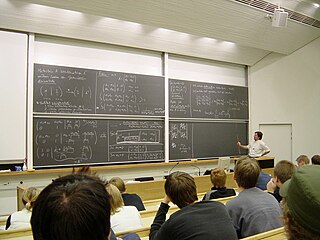
Algebraic geometry is a branch of mathematics, classically studying zeros of multivariate polynomials. Modern algebraic geometry is based on the use of abstract algebraic techniques, mainly from commutative algebra, for solving geometrical problems about these sets of zeros.
In mathematics, an equation is a statement that asserts the equality of two expressions. The word equation and its cognates in other languages may have subtly different meanings; for example, in French an équation is defined as containing one or more variables, while in English any equality is an equation.
A computer algebra system (CAS) is any mathematical software with the ability to manipulate mathematical expressions in a way similar to the traditional manual computations of mathematicians and scientists. The development of the computer algebra systems in the second half of the 20th century is part of the discipline of "computer algebra" or "symbolic computation", which has spurred work in algorithms over mathematical objects such as polynomials.
In commutative algebra and algebraic geometry, elimination theory is the classical name for algorithmic approaches to eliminating some variables between polynomials of several variables, in order to solve systems of polynomial equations.

In contemporary education, mathematics education is the practice of teaching and learning mathematics, along with the associated scholarly research.
In mathematics, an algebraic equation or polynomial equation is an equation of the form
In algebra, the theory of equations is the study of algebraic equations, which are equations defined by a polynomial. The main problem of the theory of equations was to know when an algebraic equation has an algebraic solution. This problem was completely solved in 1830 by Évariste Galois, by introducing what is now called Galois theory.
Seventh grade, equivalent to Year 8 in England and Wales, and S1 in Scotland, is a year of education in many nations. The seventh grade is the seventh school year after kindergarten. Students are usually 12–13 years old.
Feng Kang was a Chinese mathematician and scientist.
Principles and Standards for School Mathematics (PSSM) are guidelines produced by the National Council of Teachers of Mathematics (NCTM) in 2000, setting forth recommendations for mathematics educators. They form a national vision for preschool through twelfth grade mathematics education in the US and Canada. It is the primary model for standards-based mathematics.
The National Council of Teachers of Mathematics (NCTM) was founded in 1920. It provides services concerning mathematics education in the United States and Canada.
Mathematics education in New York in regard to both content and teaching method can vary depending on the type of school a person attends. Private school math education varies between schools whereas New York has statewide public school requirements where standardized tests are used to determine if the teaching method and educator are effective in transmitting content to the students. While an individual private school can choose the content and educational method to use, New York State mandates content and methods statewide. Some public schools have and continue to use established methods, such as Montessori for teaching such required content. New York State has used various foci of content and methods of teaching math including New Math (1960s), 'back to the basics' (1970s), Whole Math (1990s), Integrated Math, and Everyday Mathematics.
Muntinlupa Science High School, known as Muntinlupa Science or MunSci, is a special science public high school in the City of Muntinlupa, Philippines that provides a technical and science curriculum that aims to prepare students for careers in science and technology, math, and communication arts.
Regional Science High School Union (RSHS-Union) is a specialized system of public secondary schools in the Philippines, established during the 1994-1995 school year. It is operated and supervised by the Department of Education, with a curriculum heavily focusing on math and science. It remains within the ambit of the Department of Education, unlike the specialized science high school system of national scope, the Philippine Science High School.
The following outline is provided as a topical overview of science:
Saint John's School is a private coeducational school located in the Condado neighborhood of San Juan, Puerto Rico.
Saint Albert High School is a private, Roman Catholic high school in Council Bluffs, Iowa, USA. It is part of a chain of private schools going from pre-kindergarten through 12th Grade. Saint Albert's Mascot is a falcon for the boys, while the girls are known as the saintes. It is located in the Roman Catholic Diocese of Des Moines.
Algebra is one of the broad parts of mathematics, together with number theory, geometry and analysis. In its most general form, algebra is the study of mathematical symbols and the rules for manipulating these symbols; it is a unifying thread of almost all of mathematics. It includes everything from elementary equation solving to the study of abstractions such as groups, rings, and fields. The more basic parts of algebra are called elementary algebra; the more abstract parts are called abstract algebra or modern algebra. Elementary algebra is generally considered to be essential for any study of mathematics, science, or engineering, as well as such applications as medicine and economics. Abstract algebra is a major area in advanced mathematics, studied primarily by professional mathematicians.
Caraga Regional Science High School is a public school in San Juan, Surigao City, Philippines. Caraga RSHS is the leading school in the Division of Surigao City with high MPS during the annual National Achievement Tests (NAT), and has been consistent in making its name in Division, Regional, National and International level contests.
Vladimir P. Gerdt is a Russian mathematician and a full professor at the Joint Institute for Nuclear Research (JINR) where he is the head of the Group of Algebraic and Quantum Computations. His research interests are concentrated in computer algebra, symbolic and algebraic computations, algebraic and numerical analysis of nonlinear differential equations, polynomial equations, applications to mathematics and physics, and quantum computation with over 210 published articles.





